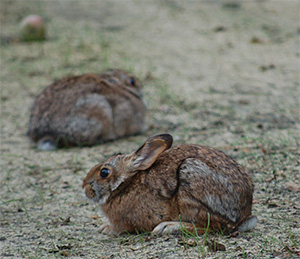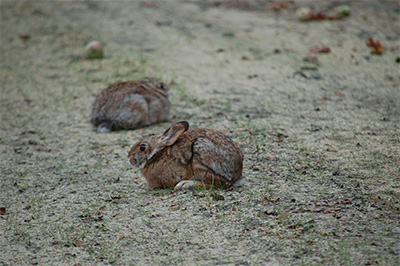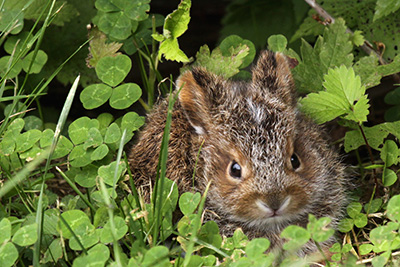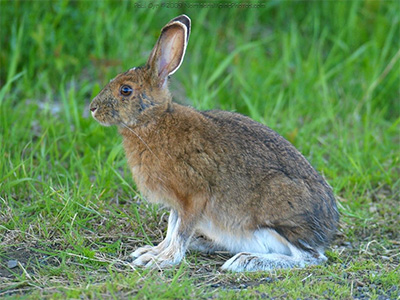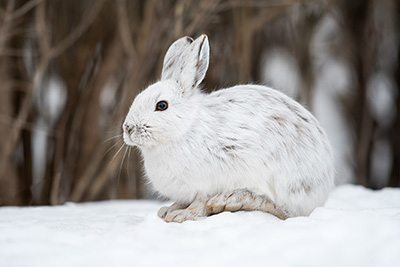Home → Fish & Wildlife → Wildlife → Species Information → Mammals → New England Cottontail and Snowshoe Hare → Rabbit Sightings
Rabbit Sightings
Have you seen a rabbit lately? Keep an eye out and help us protect Maine’s only native rabbit.
On this page:
- About New England cottontail
- Report a sighting
- Rabbit identification
- Management and conservation of NEC
- History of the rabbit sighting project
- Where you might see NEC
- Other rabbit and hare species in Maine
About the New England Cottontail
The New England cottontail (NEC; Sylvilagus transitionalis), or cooney, is Maine’s only native true rabbit, and was once common in southern Maine, ranging from Kittery to Belfast. However, NEC populations have declined dramatically in Maine and across their entire range (New England and eastern New York). Due to the declining population, MDIFW listed the species as State Endangered in 2007. Today, NEC are known to occur in just 6 towns: Cape Elizabeth, Scarborough, Wells, York, Kittery, and Eliot; with a statewide population of less than 300 individuals. The range-wide decline of NEC has been attributed to habitat loss, particularly the loss of old field, shrubland, and young forest habitats. These habitat types provide dense cover that protect the rabbits from avian and terrestrial predators. These habitats were once relatively common in southern Maine, but now makes up less than 3% of the landscape.
MDIFW is working collaboratively with many partners to restore Maine’s NEC. Habitat creation and enhancement is the largest aspect of the restoration effort.
To continue restoring this endangered species, MDIFW needs more eyes! The Department is asking the public to be on the lookout for potential NEC and to report their sightings. MDIFW will conduct surveys in the vicinity of credible sightings to search for currently unknown populations. Any new confirmations of the species will greatly enhance our restoration effort by allowing us to protect the population and provide additional opportunities for us to conduct habitat management that will ultimately increase Maine’s cottontail population.
Report a sighting
If you see a rabbit that might be a New England cottontail or an Eastern cottontail, please take note of the following:
- Date
- Time
- Location
- Town
- What habitat the rabbit was in (shrubs, forest, backyard, etc.)
- Characteristics of what led you to believe it was a cottontail (please do not report known snowshoe hares) – find what to look for below!
- If you can grab a photo, even better!
We suspect sightings only in southern and coastal Maine.
Identification
Although the New England cottontail is the only true rabbit native to Maine, the similar Eastern cottontail (nonnative) and the larger snowshoe hare are also found in Maine. All three species have a white “cotton” tail. Below are a few ways to tell the difference. Due to similarities in appearance, the most reliable method for differentiating the species is through genetic testing.
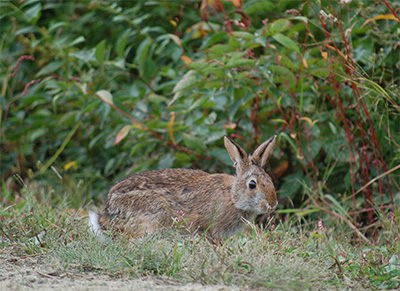
Photo Credit: Wells Reserve at Laudholm
New England Cottontail
Medium-sized rabbits
14-17 inches long
1-2.5 pounds
Dark brown fur with a wash of black-tipped fur
Black edge to their ears
Black spot between the ears (typically not seen at a distance)
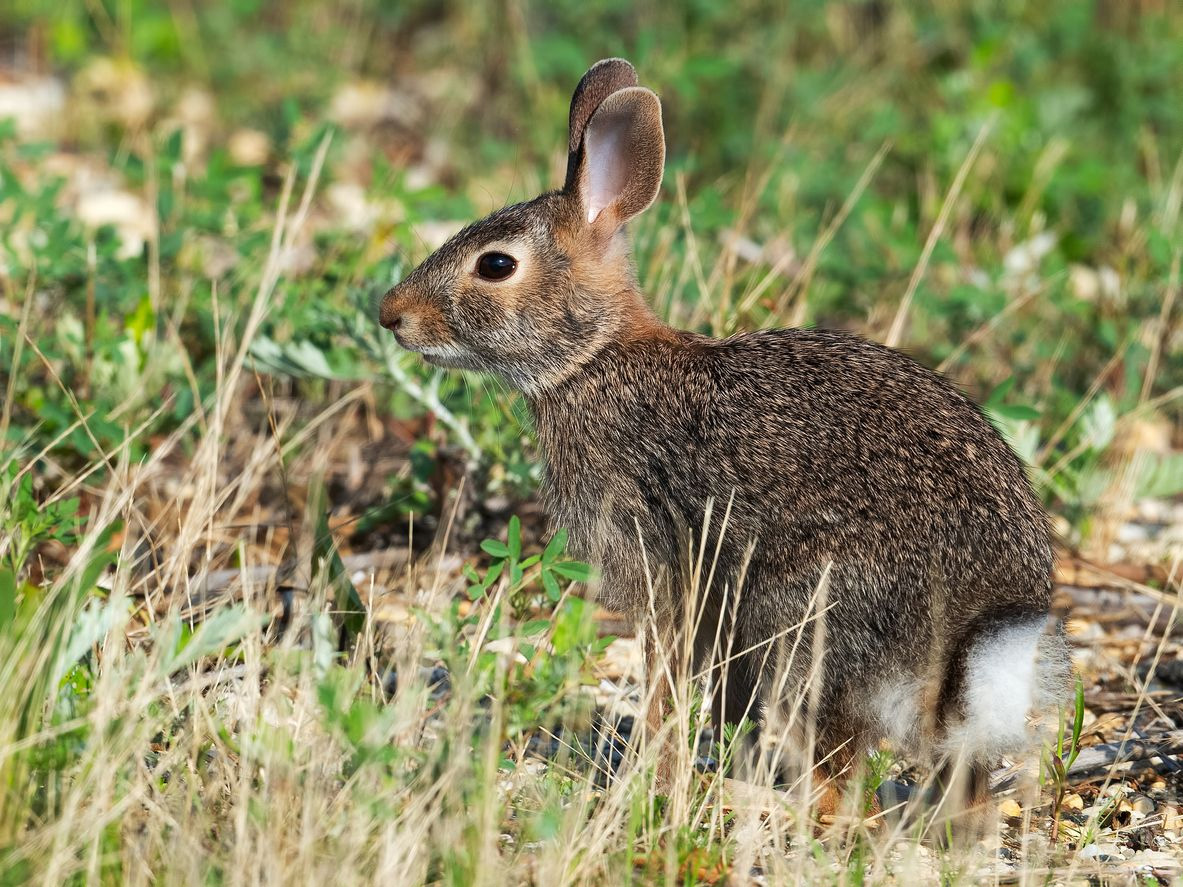
Photo Credit: Paul Cyr
Eastern Cottontail
Very similar to NEC, a white spot on the forehead (which NEC never have)
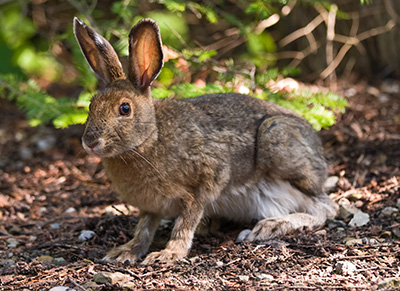
Snowshoe Hare
Larger than cottontails
2.5-4 pounds
Longer feet and ears than NEC
White in the winter, brown fur the rest of the year
White edge to the ears
Hare leverets (young born that year) also have more of a grizzled appearance. May have a white spot on forehead similar to Eastern cottontail
What is MDIFW doing to restore NEC?
MDIFW is working collaboratively with many partners to restore Maine’s NEC. Habitat creation and enhancement is the largest aspect of the restoration effort. To date, we’ve conducted habitat management on hundreds of acres under all types of landownership, including state, federal, municipal, land trust, and privately owned properties. In addition to habitat work and to help supplement the local population, MDIFW has released NEC that were born and raised as part of a captive breeding program. Learn more about NEC restoration efforts in Maine and across New England by visiting the New England cottontail website page or youngforest.org
History of the rabbit sighting project
MDIFW began this community science project in December 2021 to help discover currently unknown NEC populations. In the first year, the Department received nearly 330 reports from the public, including 19 confirmed New England cottontails (mostly from Cape Elizabeth). Most reports were snowshoe hare or unidentifiable (not enough information to make a determination). There are several promising reports MDIFW will survey winter 2022-2023 to determine if NEC are present. Thank you to everyone who shared their sightings with us, we look forward to receiving your future rabbit sightings!
Where might I see New England cottontails?
New England cottontails are difficult to observe in the wild because they stick to thickets to hide from predators. However, they do venture out into the open to forage on occasion, particularly at night. So, watching field/thicket edges at dawn and dusk are the best times to spot one. The Wells National Estuarine Research Reserve in Wells has hiking trails through thickets occupied by NEC, and we annually receive reports of sightings. Kettle Cove, Crescent Beach, and Two Lights State Parks in Cape Elizabeth are also locations were sharp-eyed visitors may spot a cottontail. Although there are no cottontails there (yet!), MDIFW is managing 65 acres of Scarborough Marsh Wildlife Management Area off from Manson Libby Rd in Scarborough to provide suitable habitat. The area provides a good opportunity to witness the results of habitat management that we’ve undertaken to benefit the species, including a clear-cut, plantings of native shrubs, and allowing an old field to revert to shrubland. Although the rabbits haven’t found it yet, the shrubland and young forest dependent bird species certainly have! American woodcock, alder flycatchers, black-billed cuccoos, common yellowthroat, chestnut-sided warblers, and others have been documented on site and are benefitting from our management.
Other rabbit and hare species in Maine
Eastern Cottontail
The eastern cottontail (Sylvilagus floridanus) is not native to New England, but was introduced in the late 1800s and early 1900s. They are well established in southern New England (including southern New Hampshire), but were not known to occur in Maine until recently. In Maine, the first population was confirmed in 2017 in Kittery, with other populations confirmed in South Berwick and Portland in 2021. Single individuals have also been confirmed in other towns, including York, Limerick, North Berwick, and Cumberland. Although they dispersed into Kittery on their own (hopping over the bridge from Portsmouth, NH), the mechanism for getting to other towns is unknown. However, in 2015 we confirmed a nest of eastern cottontails in a shipment of potted plants from New Jersey, thus documenting that they occasionally hitch hike into Maine from other states. If you ever spot a rabbit (or other wild animal) escaping from a shipment that came from out of state, please notify MDIFW so we can investigate the incident and respond accordingly.
Eastern cottontails use similar habitats (shrubland and young forest) as New England cottontails. However, they have better vision than NEC, and as a result are more willing to venture out into the open. Therefore, they can occur in smaller, more fragmented habitat patches, and even in highly developed suburban areas with little shrubby cover. Where they occur, they frequently come out onto lawns, which New England cottontails do much less frequently (and typically stick close to cover when they do). Unfortunately, when eastern cottontails colonize areas with NEC they tend to outcompete and ultimately replace them. The combination of competition from eastern cottontails, habitat loss, and other factors has a resulted in many areas of New England flipping from being occupied by New England cottontails with no eastern cottontails, to an eastern cottontail occupied landscape with no NEC.
Snowshoe Hare
The snowshoe hare (Lepus americanus) is a common game species that occurs statewide in Maine. Although they are often referred to as rabbits, they technically are not (they’re hares, which are a related but distinct group). Their fur changes from brown in summer to white in winter, which along with large snowshoe shaped feet makes them well adapted to surviving snowy Maine winters. Like cottontails, they occur in young forest habitats, but hares are most common in thick young conifer stands, which cottontails typically do not occur in. It’s uncommon, but hares and New England cottontails occasionally co-occur in patches of deciduous young forest. In one instance in Massachusetts, hares, New England cottontails, and eastern cottontails were documented occurring in the same habitat patch!
